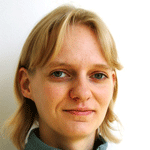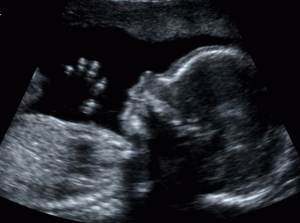Blogger: Kari Williamson
You lie there with gel on your stomach and glance towards the ultrasound screen. There he is, the little one, who will arrive in four-five months’ time. The emotions, questions, the joy, the worry, they all crowd in – and the midwife gives and understanding nod.
This is how many of us imagine the experience of the first ultrasound consultation offered to all pregnant women in Norway at week 18. There is a lot of technological and medical research and innovation behind this half-hour consultation, but what about the human aspect? What about the pregnant woman and her partner? How do they experience this meeting?
This is what midwife Liv Øyen at NTNU and the National centre for foetal medicine at St. Olavs Hospital has looked at in more detail. After nearly 30 years as a midwife and around 14 years as an ultrasound-teacher, the meetings with pregnant women and their partners have been many. And some central questions have emerged:
- What is the pregnancy ultrasound all about?
- How should it be done? How should it be communicated?
- What do the pregnant women themselves think about this offer at week 18?
Medical and personal
The pregnancy ultrasound is primarily for medical reasons. The information brochure from the Norwegian Directorate of Health on pregnancy ultrasound, says that the consultation is a check-up on the foetus and the uterus to gain information about the age of the foetus, the number of foetuses, the location of the placenta and the foetus’ anatomy and development.
But if you ask expecting parents about the pregnancy ultrasound, this is not their main concern. Of course they want to know if everything is ok medically, but it is the experience of seeing their child for the first time that they talk about. There is actually a new life in there, and someone is about to become a parent.
Øyen has interviewed eight pregnant women for her master thesis, and the responses indicate that they wish for the midwife to acknowledge the impact of this first visual meeting. They also want a dialogue – not just a monologue of technical and medical data. In short, they want to be met as human beings, as a family.
This may sound difficult to achieve in a mere 30-minute consultation, but Øyen does not believe it actually takes much. The key is to see the persons coming in through the door and make them feel acknowledged.
This is something Øyen wishes to bring into the ultrasound training for midwives by introducing theories such as Tor-Johan Ekeland’s on therapeutic communication. The theory states that communication and information are not the same thing – in order to really communicate, there has to be a relationship in place.

Øyen’s aim is therefore to educate compassionate midwives who see the couples coming through the door and focus on the person rather than just the technology. “The most important thing is to create a bond between mother, father and child. This is the pivotal point,” one of the women in the survey said.
It is after all call pregnancy CARE.


